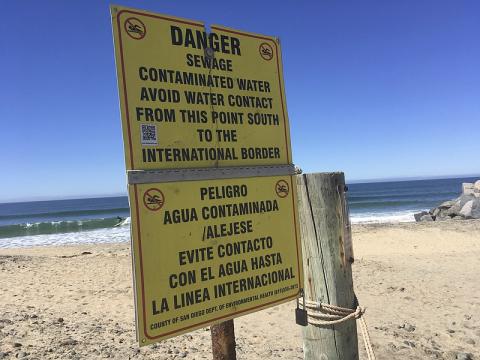<p></p>
<p>Sewage spilling into the ocean from the Tijuana River Valley forced the closure of beaches from the border through Imperial Beach on Wednesday.</p>
<p>The closure by the San Diego County Environmental Health Department came after rain earlier in the week caused new sewage runoff from Tijuana to flow into the US through the Tijuana River and eventually into the Pacific Ocean near the border.</p>
<p>County health officials warned beachgoers to avoid contact with the ocean water for 72 hours after rainfall ends. Signs were placed along the beach areas to the Imperial Beach Pier.</p>
<p>The Tijuana River in Mexico usually flows less than 30 million gallons a day and is diverted to a sewage treatment plant in Mexico under a water quality treaty between the United States and Mexico that has led to improved water quality along San Diego beaches during the summer.</p>
<p>But during the winter, or after rainstorms, the Tijuana River treatment plant is shut down and forces millions of gallons of stormwater runoff into enter the United States. The Tijuana River overflows into the US through the Tijuana Slough National Wildlife Refuge and Tijuana Estuary near Imperial Beach before reaching the Pacific Ocean just over a mile north of the International Border.</p>
<p>The ocean flow is unpredictable and can move the untreated sewage and river runoff either North or South, depending on winds, tides, and other factors. The County Department of Environmental Health (DEH), along with lifeguards, and other organizations monitor conditions along San Diego beaches to detect sewage impacts moving north. DEH can issue beach closures until water quality conditions improve.</p>
<p>A recent report commissioned by the US Customs and Border Protection (CBP), which patrols the border area, found that the Tijuana River runoff contained 710 times more arsenic, five times more lead, seven times more uranium, and 1,135 times more hexavalent chromium than local tap water. CBP conducted the study after many of its Border Patrol agents reported headaches, rashes, infections, and breathing problems from being near the sewage during their shifts. In a six-month period from June to December 2017, 83 Border Patrol agents reported sewage-related illnesses.</p>
<p>Tijuana River sewage overflows can contaminate ocean beaches from the border to Coronado.</p>
<p>A study in 2017 found that Imperial Beach experienced for than 1,600 beach closures in ten years, resulting in an average of more than one-third of each year having had beach closures.</p>
<p>The recently signed international trade agreement between the US, Mexico, and Canada that replaces NAFTA included $300 million in funding to help address raw sewage spilling into the Tijuana River Valley from Mexico, in addition to $25 million for the EPA’s Border Water Infrastructure Program included in this year’s federal budget passed by Congress.</p>
<p>The US Mexico Canada Agreement, called USMCA, signed by President Trump on January 29, addressed environmental problems like the Mexican sewage flow across the border as part of the international trade agreement.</p>
Image
Image

Category